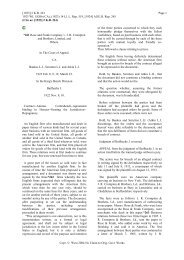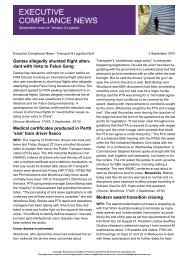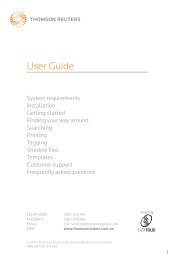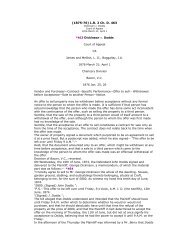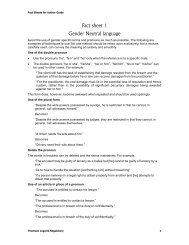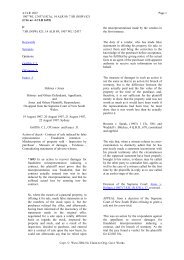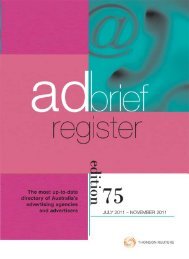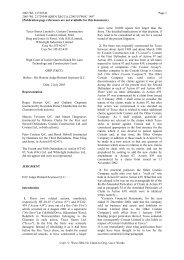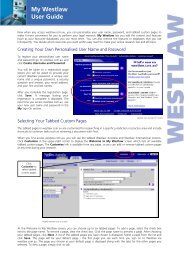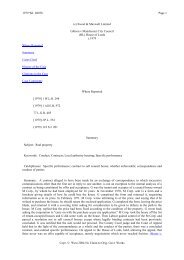Chapter 23: Product Liability - Thomson Reuters
Chapter 23: Product Liability - Thomson Reuters
Chapter 23: Product Liability - Thomson Reuters
Create successful ePaper yourself
Turn your PDF publications into a flip-book with our unique Google optimized e-Paper software.
155Ch <strong>23</strong>: <strong>Product</strong> <strong>Liability</strong>foolproof quality control may in practice be unattainable and not eveneconomically optimal, the risk must be shouldered by the manufacturer andcannot be escaped by pleading that inevitable and unpredictable flaws areunavoidable nor that the extra cost of super-controls would be unjustifiable.Here liability is truly strict.If the plaintiff establishes the existence of a defect in the product and the factof injury, the court will infer liability unless the manufacturer proves, on thebalance of probabilities, that the defect was not present when it supplied thegoods. 184The consumer expectation standard presents more difficulty in relation todesign defects and failure to warn. Easy enough are malfunctioning productssuch as collapsing jacks or sticking carburettors. The difficulty concerns caseswhere the appropriate standard of safety is a matter of opinion, especially wherethe particular design was consciously adopted in preference over competingalternatives. To vet the designer’s choice may involve the judicial process inunfamiliar, even unjusticiable, inquiry, exacerbated by the fact that an adverseconclusion will condemn a whole production line rather than merely a singleitem. How safe is safe enough? The roof of a car overturned in a collision mightnot have collapsed if the steel had been stronger and the car had been equippedwith a roll bar (“crash-proof”). But such added safety would have been at thecost of consumer appeal and fuel economy. It would be different if an alternativedesign or additional safety device were readily available at small cost.The consumer expectation test predicated by theECDirective and adopted inthe Australian Consumer Law has lost much of its credibility in the UnitedStates, at least in relation to design defects. 185 It makes little sense to use it inrelation to complex products, the design and operation of which are beyond theeveryday experience of ordinary consumers. 186 As well, it precludes (instead ofmerely being relevant to) a finding of defectiveness for obvious dangers. 187 As aresult, courts in the United States increasingly supplement or replace use of theconsumer expectation test with an alternative test known as the risk/utilitytest. 188DRAFTThe risk/utility (or cost/benefit) test calls for weighing the likelihood that theproduct would cause the plaintiff’s harm against the burden on the manufacturerto design a product that could have prevented that harm. Essentially, it requiresa comparison with a suggested alternative design, from the viewpoint of thereasonable person. 189 In short, it is the traditional reasonableness test in184 AustralianConsumerLaw, s 142(a)(ii) (formerlyTradePracticesAct1974 (Cth), s 75AK(1));Carey-HazellvGetzBros&Co(Aust)PtyLtd [2004] FCA 853;EffemFoodsLtdvNicholls[2004] NSWCA 332.185 A few states continue to use only the consumer expectation test: see, for example, Green vSmith & NephewAHP, Inc, 629 NW 2d 727 (Wis 2001).186 SoulevGeneralMotorsCorp, 882 P 2d 298 (Cal 1994) (consumer expectation test not to beused for complex products).187 Camacho v Honda Motor Co Ltd, 741 P 2d 1240 (Co 1987) (consumer expectation test notto be used for products posing obvious dangers, such as a motorcycle without ankleprotectors).188 Several states have abandoned the consumer expectation test altogether: see, for example,Nichols v Union Underwear Co Inc, 602 SW 2d 429 (Ky 1980); Sperry-New Holland vPrestage, 617 So 2d 248 (Miss 1993).189 See, for example, Banks v ICI Americas Inc, 450 SE 2d 671 (Ga 1994). The Rest 3rd:<strong>Product</strong>s <strong>Liability</strong>, s 2(b) would make proof of a reasonable alternative design (RAD) anecessary condition. As noted above, n 161, no state has yet adopted this Restatement.session: 5 October 28, 2010 page no: 20 folio no: 155@syd-tlrapp-p19/syd-tlrapp-p191/CLS_law/GRP_flemings/JOB_update10/DIV_19PROOF COPY



